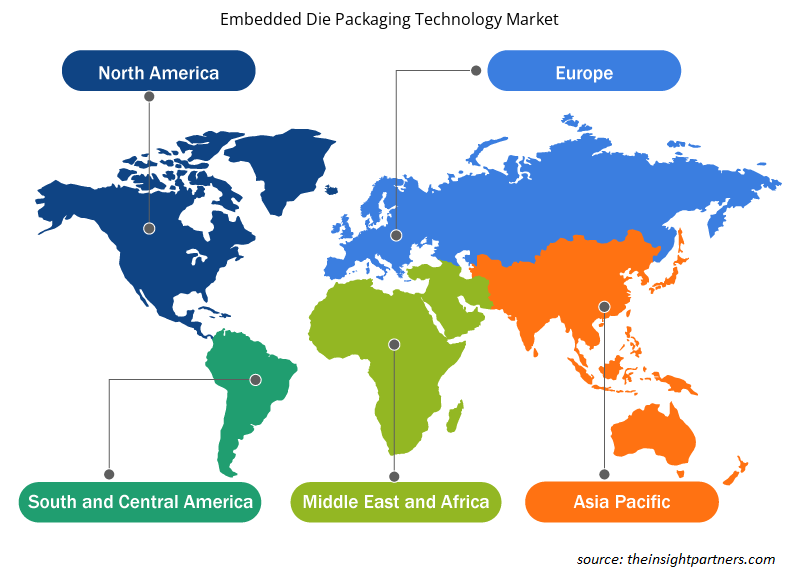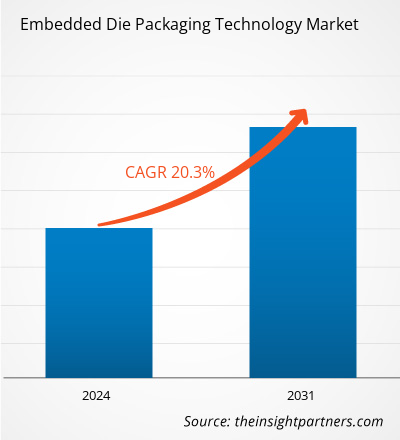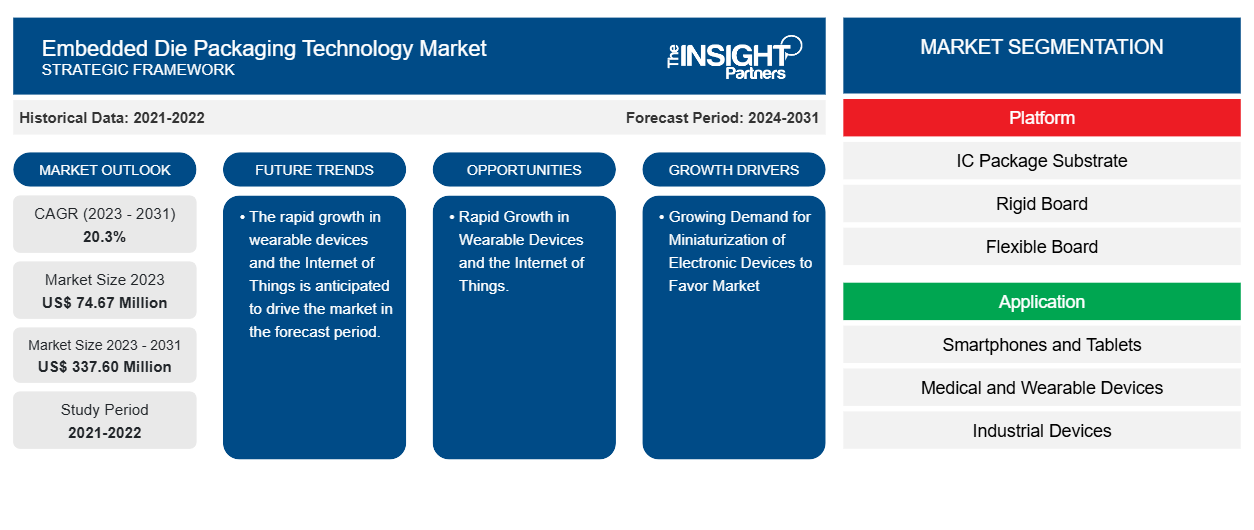Le marché des technologies de conditionnement de puces intégrées devrait atteindre 337,60 millions USD d'ici 2031, contre 74,67 millions USD en 2023. Le marché devrait enregistrer un TCAC de 20,3 % au cours de la période 2023-2031. La demande croissante de miniaturisation des appareils électroniques et les développements croissants dans la technologie de conditionnement de puces intégrées sont susceptibles d'être les principaux moteurs et tendances du marché.CAGR of 20.3% during 2023–2031. The growing demand for the miniaturization of electronic devices and rising developments in embedded die packaging technology are likely to be the key drivers and trends of the market.
Analyse du marché des technologies d'emballage à matrice intégrée
Le marché des technologies d'emballage de puces intégrées connaît une croissance significative à l'échelle mondiale. Cette demande croissante de miniaturisation des appareils électroniques et les développements croissants dans la technologie d'emballage de puces intégrées. En outre, la demande croissante d'amélioration des performances des smartphones et des appareils automobiles et la croissance rapide des appareils portables et de l'Internet des objets sont parmi d'autres facteurs qui soutiennent la croissance du marché des logiciels de gestion de la promotion commerciale.
Aperçu du marché des technologies d'emballage sous matrice intégrée
Le conditionnement des puces intégrées est différent de la plupart des types de conditionnement. En général, dans de nombreux conditionnements de circuits intégrés, les dispositifs sont situés sur un substrat. Le substrat sert de pont entre les dispositifs et une carte dans un système.
Personnalisez ce rapport en fonction de vos besoins
Vous bénéficierez d'une personnalisation gratuite de n'importe quel rapport, y compris de certaines parties de ce rapport, d'une analyse au niveau des pays, d'un pack de données Excel, ainsi que de superbes offres et réductions pour les start-ups et les universités.
- Obtenez les principales tendances clés du marché de ce rapport.Cet échantillon GRATUIT comprendra une analyse de données, allant des tendances du marché aux estimations et prévisions.
Moteurs et opportunités du marché de la technologie d'emballage sous matrice intégrée
La demande croissante de miniaturisation des appareils électroniques favorise le marché
La demande croissante de miniaturisation des appareils électroniques stimule en effet le marché. La miniaturisation des appareils électroniques consiste à intégrer davantage de nœuds de transistors sur un circuit intégré (CI) plus petit. Le CI est ensuite interfacé avec le système ou l'appareil prévu afin qu'une fois assemblé, le système puisse exécuter la fonction souhaitée. La technologie est rendue plus petite mais plus puissante. De plus, en intégrant la puce dans le substrat, l'empreinte globale du boîtier électronique est considérablement réduite. Cela est particulièrement avantageux pour les applications où l'espace est limité, comme dans les appareils mobiles, les objets portables et les implants médicaux.
Croissance rapide des appareils portables et de l’Internet des objets.
La croissance rapide des appareils portables et de l'Internet des objets devrait offrir de nombreuses opportunités pour le marché des technologies de conditionnement de puces intégrées dans les années à venir. Les appareils portables sont sur le point de rejoindre les frontières entre les mondes physique et numérique. Les lunettes de réalité augmentée superposeront des informations sur l'environnement d'un individu, offrant une navigation en temps réel, une aide à la traduction et même des visites personnalisées de la ville. La technologie de conditionnement de puces intégrées permet aux appareils portables de se loger dans de nombreux boîtiers de circuits intégrés. Les appareils sont situés au-dessus d'un substrat.IC packages. The devices are situated on top of a substrate.
Analyse de segmentation du rapport sur le marché des technologies d'emballage sous matrice intégrée
Les segments clés qui ont contribué à l’élaboration de l’analyse du marché de la technologie d’emballage de matrices intégrées sont la plate-forme, l’application et l’industrie.
- Sur la base de la plateforme, le marché de la technologie de conditionnement de puces intégrées est divisé en substrat de boîtier de circuit intégré, carte rigide et carte flexible. Le segment des substrats de boîtier de circuit intégré devrait détenir une part de marché importante au cours de la période de prévision.IC package substrate, rigid board, and flexible board. The IC package substrate segment is anticipated to hold a significant market share in the forecast period.
- En fonction des applications, le marché des technologies d'emballage de matrices intégrées est divisé en smartphones et tablettes, appareils médicaux et portables, appareils industriels, appareils de sécurité et autres applications. Le segment des smartphones et tablettes devrait détenir une part de marché importante au cours de la période de prévision.
- Le marché est segmenté en fonction des secteurs d'activité : électronique grand public, informatique et télécommunications, automobile , santé, etc. L'aérospatiale et la défense devraient détenir une part de marché importante au cours de la période de prévision.
Analyse des parts de marché de la technologie d'emballage sous matrice intégrée par zone géographique
La portée géographique du rapport sur le marché de la technologie d'emballage sous forme de matrice intégrée est principalement divisée en cinq régions : Amérique du Nord, Asie-Pacifique, Europe, Moyen-Orient et Afrique, et Amérique du Sud et centrale.
L'Amérique du Nord domine le marché des technologies d'emballage de matrices intégrées. Les tendances d'adoption de haute technologie dans diverses industries de la région nord-américaine ont alimenté la croissance du marché des technologies d'emballage de matrices intégrées. Des facteurs tels que l'adoption accrue d'outils numériques, les dépenses technologiques élevées des agences gouvernementales, la demande croissante de miniaturisation des appareils électroniques et les développements croissants dans la technologie d'emballage de matrices intégrées devraient stimuler la croissance du marché nord-américain des technologies d'emballage de matrices intégrées. De plus, l'accent mis sur la recherche et le développement dans les économies développées des États-Unis et du Canada oblige les acteurs nord-américains à apporter des solutions technologiquement avancées sur le marché. En outre, les États-Unis comptent un grand nombre d'acteurs du marché des technologies d'emballage de matrices intégrées qui se concentrent de plus en plus sur le développement de solutions innovantes. Tous ces facteurs contribuent à la croissance du marché des technologies d'emballage de matrices intégrées de la région.fuelled the growth of the embedded die packaging technology market. Factors such as increased adoption of digital tools, high technological spending by government agencies, the growing demand for the miniaturization of electronic devices, and rising developments in embedded die packaging technology are expected to drive the North American embedded die packaging technology market growth. Moreover, a strong emphasis on research and development in the developed economies of the US and Canada is forcing the North American players to bring technologically advanced solutions into the market. In addition, the US has a large number of embedded die packaging technology market players who have been increasingly focusing on developing innovative solutions. All these factors contribute to the region's growth of the embedded die packaging technology market.
Aperçu régional du marché des technologies d'emballage à matrice intégrée
Les tendances et facteurs régionaux influençant le marché de la technologie d’emballage sous matrice intégrée tout au long de la période de prévision ont été expliqués en détail par les analystes d’Insight Partners. Cette section traite également des segments et de la géographie du marché de la technologie d’emballage sous matrice intégrée en Amérique du Nord, en Europe, en Asie-Pacifique, au Moyen-Orient et en Afrique, ainsi qu’en Amérique du Sud et en Amérique centrale.

- Obtenez les données régionales spécifiques au marché de la technologie d'emballage sous matrice intégrée
Portée du rapport sur le marché des technologies d'emballage sous matrice intégrée
| Attribut de rapport | Détails |
|---|---|
| Taille du marché en 2023 | 74,67 millions de dollars américains |
| Taille du marché d'ici 2031 | 337,60 millions de dollars américains |
| Taux de croissance annuel composé mondial (2023-2031) | 20,3% |
| Données historiques | 2021-2022 |
| Période de prévision | 2024-2031 |
| Segments couverts | Par plateforme
|
| Régions et pays couverts | Amérique du Nord
|
| Leaders du marché et profils d'entreprises clés |
|
Densité des acteurs du marché des technologies d'emballage sous matrice intégrée : comprendre son impact sur la dynamique commerciale
Le marché des technologies d'emballage sous matrice intégrée connaît une croissance rapide, tirée par la demande croissante des utilisateurs finaux en raison de facteurs tels que l'évolution des préférences des consommateurs, les avancées technologiques et une plus grande sensibilisation aux avantages du produit. À mesure que la demande augmente, les entreprises élargissent leurs offres, innovent pour répondre aux besoins des consommateurs et capitalisent sur les tendances émergentes, ce qui alimente davantage la croissance du marché.
La densité des acteurs du marché fait référence à la répartition des entreprises ou des sociétés opérant sur un marché ou un secteur particulier. Elle indique le nombre de concurrents (acteurs du marché) présents sur un marché donné par rapport à sa taille ou à sa valeur marchande totale.
Les principales entreprises opérant sur le marché des technologies d'emballage sous forme de matrice intégrée sont :
- Technologie Amkor, Inc.
- Groupe ASE
- AT & S Autriche Technologie & Systemtechnik Aktiengesellschaft
- Fujikura Ltd.
- Compagnie Générale d'Électricité
- INANE-ON TECHNOLOGIES AG
Avis de non-responsabilité : les sociétés répertoriées ci-dessus ne sont pas classées dans un ordre particulier.

- Obtenez un aperçu des principaux acteurs du marché des technologies d'emballage sous matrice intégrée
Actualités et développements récents du marché de la technologie d'emballage sous matrice intégrée
Le marché de la technologie d'emballage de matrices intégrées est évalué en collectant des données qualitatives et quantitatives après des recherches primaires et secondaires, qui comprennent des publications d'entreprise importantes, des données d'association et des bases de données. Quelques-uns des développements du marché de la technologie d'emballage de matrices intégrées sont répertoriés ci-dessous :
- ASE promeut le packaging de puces intégrées pour l'électronique automobile. La société ASE Technology développera en interne sa technologie de puces intégrées, baptisée « Advanced Embedded Active System Integration (ASI), principalement appliquée au traitement des modules électroniques automobiles (Source : site Web de la société ASE, mai 2024)
Rapport sur le marché de la technologie d'emballage sous matrice intégrée et livrables
Le rapport « Taille et prévisions du marché de la technologie d’emballage sous matrice intégrée (2021-2031) » fournit une analyse détaillée du marché couvrant les domaines ci-dessous :
- Taille et prévisions du marché de la technologie d’emballage sous forme de matrice intégrée aux niveaux mondial, régional et national pour tous les segments de marché clés couverts dans le cadre.
- Tendances du marché de la technologie d’emballage sous forme de matrice intégrée ainsi que dynamique du marché telles que les moteurs, les contraintes et les opportunités clés.
- Analyse détaillée des cinq forces de PEST/Porter et SWOT.
- Analyse du marché de la technologie d’emballage sous matrice intégrée couvrant les principales tendances du marché, le cadre mondial et régional, les principaux acteurs, les réglementations et les développements récents du marché.
- Analyse du paysage industriel et de la concurrence couvrant la concentration du marché, l'analyse de la carte thermique, les principaux acteurs et les développements récents sur le marché de la technologie d'emballage de matrices intégrées.
- Profils d'entreprise détaillés.
- Analyse historique (2 ans), année de base, prévision (7 ans) avec TCAC
- Analyse PEST et SWOT
- Taille du marché Valeur / Volume - Mondial, Régional, Pays
- Industrie et paysage concurrentiel
- Ensemble de données Excel
Rapports récents
Rapports connexes
Témoignages
Raison d'acheter
- Prise de décision éclairée
- Compréhension de la dynamique du marché
- Analyse concurrentielle
- Connaissances clients
- Prévisions de marché
- Atténuation des risques
- Planification stratégique
- Justification des investissements
- Identification des marchés émergents
- Amélioration des stratégies marketing
- Amélioration de l'efficacité opérationnelle
- Alignement sur les tendances réglementaires





















 Obtenez un échantillon gratuit pour - Marché des technologies d'emballage à matrice intégrée
Obtenez un échantillon gratuit pour - Marché des technologies d'emballage à matrice intégrée